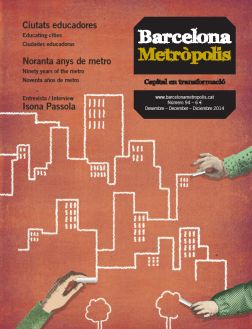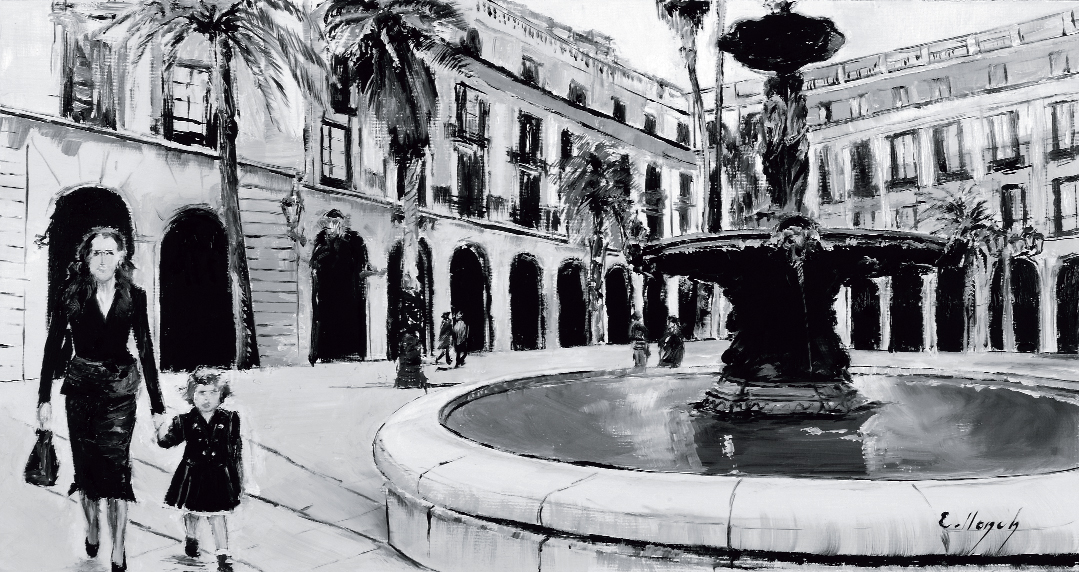It is like a network of layered spaces, many of them lost, many of them irrevocably transformed, some of them only accessed through uncertain memories or even less faithful photos.
Last scene of all,
That ends this strange eventful history,
Is second childishness and mere oblivion,
Sans teeth, sans eyes, sans taste, sans everything.
(From the soliloquy “The seven ages of man” in Shakespeare’s As you like it.)
There is an image I have of my childhood in which two little girls wearing matching purple flared dungarees hold hands with their rather hipster mother in her bell-bottom jeans set against a rather garish (almost technicolour through over-exposure) image of the Plaça de Catalunya. What must the date have been? 1976? 1977? I suppose because of the colours I somehow imagine it as being after Franco, but maybe only just. The strangest thing for me, in retrospect, is – as in many of the photos from early childhood visits to Barcelona, taken on the enormous promenades of the Gran Via, the Rambla and in those days the Carrer Urgell – the sense of space around us, something almost unimaginable in central Barcelona on a clear day today, either on the remodelled and renovated (but somehow greyer and less inviting) Plaça or on any of the other pedestrianised thoroughfares of the city. The Rambla, too, I remember with fondness from afternoons spent wandering past noisy, colourful and impossibly desirable stalls, or seated for a few pesetas with my grandparents on the double rows of chairs set up near the very top to watch the spectacle of the world wander by in their afternoon best. Repeated, ritual pleasures that remain with me far more strongly than the first glimpse of any of Barcelona’s buildings or monuments or tourist hot-spots, apart perhaps from the magical landscapes of the Park Güell and the gardens of Montjuïc, sites of playful escapades in years that followed.
Of course, as history books, memoirs and many remarkable novels in Catalan have taught me, those same years were marked by heady days of historic marches and pro-democratic campaigns, none of which I have even the slightest personal memory of today. In terms of sociocultural context, what I remember from my pre-teen years is La Ruperta Fantasma from Un, dos, tres, glimpses of late night Àngel Casas as we were bustled off to bed, my grandma singing about being a yaya yéyé, and me being coaxed into a rendition of Kisses for me for mildly amused extended family. A child’s-eye Barcelona. No sign here of the fleeting pastoral landscapes that all-too-ideally sheltered English or Irish childhoods, but scattered with tiled and patterned pavements to trace, stone borders and kerbs to jump, and shadowy doorways and thresholds in which to hide – the curious, uneven spaces I would later see my own children leap and jump and teeter on, and that for many visitors to the city today fill it with so much charm.
For, notwithstanding recent alarm about wild tourist antics and shady urban crime rings, Barcelona for the occasional visitor and for many Irish families remains an ideal city to visit with children, with its plentiful beaches, parks and child-friendly bars, restaurants, markets and museums. If some areas have become no-go, then others remain ripe for adventure. This spring I accompanied my eight-year old daughter with a prized but perishable possession that was a hand-made “Superpatata”, enjoying her haphazard (but for me highly suggestive) selection of places of memory on this whirlwind tour, but also the reactions of local shopkeepers, store-holders and bar staff: “What’s the name of your lovely potato? How’s she doing? What does she say, la senyora patata?”
Now another image returns to me, via the footage taken by dancer and choreographer Àngels Margarit in her exploration of Barcelona urban flows as part of the URBs project. Video diaries filmed by Núria Font reveal the daily negotiation of a changing urban landscape by people from diverse social, cultural and generational backgrounds. Particularly poignant for me was the footage of a twenty-first century Plaça Universitat, with its concrete paving and low stone benches now most fulfillingly functional for the skaters who whizz and stutter across contemporary high-design public squares. Just a decade before, this was a landscape with trees and grass and wooden benches, frequented by slow-moving pensioners like my grandparents, who occupied the space to talk with other ageing couples about family foibles, neighbourhood scandals and the price of milk. The Barcelona of the sixth age, now somehow hidden from view. Such juxtaposition evokes for me a network of layered spaces, many of them lost, many of them irrevocably transformed, some of them only accessed through uncertain memories or even less faithful photos, with reality somehow hidden outside the frame; an urban palimpsest performed most tellingly in film and documentary footage, and through writings that attempt to preserve a layer of that landscape in the very process of erasure (like Rodoreda, like Tusquets, like Marçal). Walking in their wake, we see and hear traces of a different city, a city in translation, between languages, between ages, between worlds.
There is a story I read relatively recently by exiled Mexican-Catalan writer Maruxa Vilalta, completed after a first return visit to Barcelona as a teenager in 1949/1950. Situated in Barcelona, with references to city’s the most emblematic streets, squares and monuments, including the street in which Vilalta was born (Muntaner), and other cultural signs related to childhood, El meu dia foll [A crazy day] (1958) gives off a nostalgic aura that blurs the boundaries between past and present, reality and imagination, exploring the effects of this liminal in-between space on the constitution of the individual. In it the adolescent narrator/ protagonist takes on and inhabits different subjectivities, amongst them that of the tourist:
“The noble Barcelona yes, it was there, stately and good. But I did not realise. I thought it did not belong to me. I felt I had no right to soil it.
“The port. Heroes and flags at the foot of the column. Plaça de Macià, with its swaying palm trees. The patient stone by stone of the churches. The gardens of Montjuïc. Art. More art! Arc de Triomf. Estació de França. Everything like that, near and far. All mixed together. All full of tourists and pigeons, soldiers and squaddies, children dressed in pink, crazy people and fat bourgeois. Heat and cold. Light and shade. Ignorant and alert. Bad and good… Who was I of all these?”
But amidst the chaotic enumeration of sites, visions and sensations presented by the narrator, there is one that would certainly have exceeded the knowledge of any real tourist, that of the Plaça de Macià, which only had that name between 1931 and 1939. By the time of Vilalta’s visit, the name have been changed back to its previous –and now current– of Plaça Reial. Buried within this story we find the tragedy of a Republican and Catalanist Barcelona, hidden behind a reference that is only recognizable if we are willing to share the same language and vision of history. Through evocation of lost signs, spaces and objects, there emerges a concern with the coexistence and preservation of different temporalities in the space of the present.




